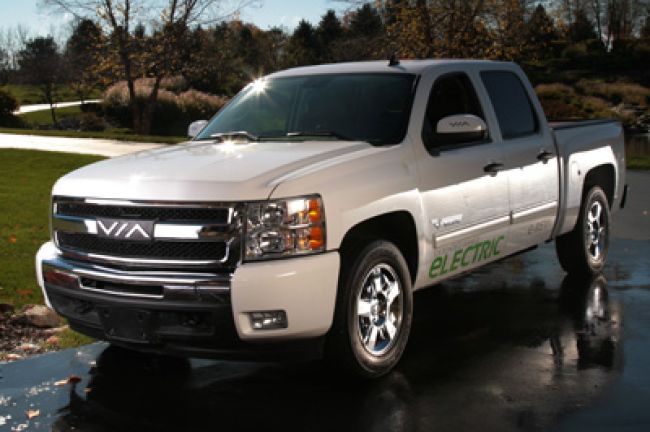
The State of Electrified Pickup Trucks in the North American Market
While a growing number of utility fleets are purchasing electrified passenger cars – like the Chevrolet Volt and Nissan Leaf – and bucket trucks with plug-in electric power takeoff capabilities, one vehicle segment still seems out of reach for electrification for most fleets: light-duty pickup trucks.
But there have been some new developments in this space that could have important implications for utility fleets. Workhorse Group says that it will unveil a concept electric truck this May at the ACT Expo in Long Beach, Calif. Earlier this year, Ford announced that it would offer a plug-in hybrid-electric version of the F-150 pickup. And XL Hybrids recently introduced a plug-in hybrid system designed for half-ton pickups.
So, what exactly are the prospects for electrified pickup trucks in North America? What are some of the key challenges to widespread fleet adoption? And when can we expect electrified pickups to become more cost-competitive with conventional-fueled trucks?
UFP recently spoke with Scott Shepard, senior research analyst with global market research and consulting firm Navigant Research (www.navigantresearch.com), to get his outlook.
UFP: Usually when fuel prices are low, there’s less interest in alternative-fuel vehicles. But we’re seeing a different trend with EVs, when you consider that about 400,000 people have paid deposits for the upcoming Tesla Model 3 and there’s a lot of buzz around the new Chevrolet Bolt and other electric passenger vehicles. On a macro level, what do you think is driving this interest in EVs despite current fuel prices?
Scott Shepard: With plug-in vehicles, the plug allows some conveniences that the conventional vehicle cannot allow – meaning that, with plug-in hybrids, you don’t have to go to the gas station that much anymore. Whether it saves you money or not, you can do most of your refueling at home. Therefore, electric vehicles are able to sidestep that whole refueling aspect.
Also, you can get some cheap electricity rates, depending on what utility service territory you’re in and how your vehicle is aggregated in the demand response program. That’s not for a majority of the market, but there is the potential there to make your energy costs so low that lower gas prices don’t register for you.
UFP: Yet in the pickup truck segment, electrification seems to be hitting a wall. Why is that?
SS: When you do the math on pickup trucks, the battery price point that would make the plug-in hybrid or the battery-electric-powered truck competitive against a conventional competitor is still below where battery prices are today.
The price points we look at suggest that you’re really not going to be within a competitive range within a few more years. When we plot out where the current technologies stand against each other, the plug-in hybrid truck and the battery-electric-powered truck have certain capability requirements that require stronger or more energy-dense batteries or larger batteries. They not only need to get you the range that you would expect from an electric passenger car, but you need to have that range competitive with your standard truck – to get to 200 to 300 miles. It’s a big cost, and it’s not easily overcome yet.
UFP: When do you see the price point of plug-in electric pickups becoming more acceptable for wider-spread adoption in utility fleets?
SS: I don’t see anything coming to the market really in the next two to three years, and even that is maybe a little bit aggressive to say three years. The reason is that whenever anyone comes to the market with an idea or a prototype that is a digital rendering, I add about three years to that expected deployment date. It takes a long time for these ideas to actually find good footing.
For these trucks to become more mainstream, it’s not going to start for a while. The rationale behind that is largely the added-on power and range requirements that these vehicles have to meet to even come to market. That doesn’t mean it’s not going to happen. I think you’re looking out to 2025 or even 2030 before you get to the point where batteries are providing the same number of miles as an internal combustion engine. Then you’ve hit the point where this option is actually viable.
At Navigant, we estimate 2016 light truck/SUV-class PHEV sales in North America were 11,500, with sales looking to double in 2017, 2018 and 2019. And our baseline projection places this class/technology sales figure at just under 300,000 by 2025.
UFP: In his “Master Plan, Part Deux,” Tesla CEO Elon Musk wrote that Tesla was going to include an electric pickup in their product mix. What are your thoughts on that?
SS: Given their timeline for new vehicle development, I would estimate that product would be about six to seven years out. [The pickup truck segment] is definitely a market that needs a vehicle – it represents nearly 30 percent of the U.S. market. So even if you’re just scratching the surface of this market, that’s huge. And nobody’s really figured out the right way to do it yet.
I think the right way to do it is probably to do it through some plug-in hybrid arrangement. And I think that’s going to come eventually from one of the established OEMs, like GM or Ford, maybe even Chrysler. Yes, if Tesla does it, that’s great. But I don’t think they’ll see near the amount of success that they’ve seen with their other vehicles.

